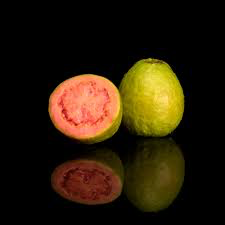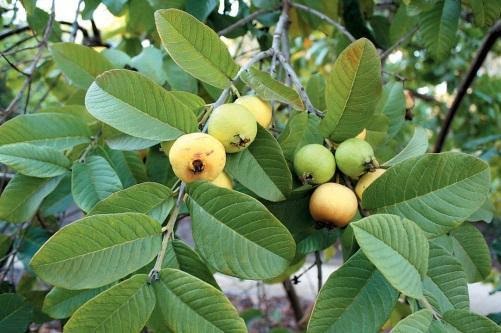Guava
Common Names: Guava
Scientific Name: Psidium guajava
Climate: Warm and moderate
Plant Description: The guava tree is a small tropical tree, can grow up to ten meters in height and has quite a lot of branches. The guava has a brown-colored bark on the outside and has a green layer underneath. The trunk can reach a diameter of 25 cm.1
The leaves are perennial and grow opposite on the branches. They are oval in shape and are about ten centimeters long and about four centimeters wide. The flowers are white with four or five white petals and fall off quickly.
The fruits are round, oval or pear-shaped, five to ten centimeters long, generally yellow or reddish yellow when ripe. When they are immature and until a very short time before ripening, the fruit is green, hard, and rubbery inside. It is native to Mexico, Central America, and northern South America.
Cultivation: The guava grows best in full sun. After planting, you need to water frequently and it is also important to keep mature trees moist when they are in bloom and producing fruit. It grows in any type of soil with good drainage.
It can be reproduced from cuttings, cutting branches about 25cm long from shoots less than one year old. The leaves of the cuttings have to be removed, leaving only two, which are cut in half. It is good to make cuts on the bark of the cuttings in order to stimulate root growth. Finally, they are placed in a wet and porous substrate. After a month the new roots develop.
Planting should preferably be done on flat or gently sloping ground with good drainage, with three to four meters between plants.
Once fully grown, you have to prune the plants to give them the shape of a tree. It is necessary to prune formation, or eliminate those branches affected by pests or diseases or those that are poorly located, and sanitation pruning, when the tree is already producing after the harvest, the branches that gave fruit must be eliminated, to stimulate the growth of new shoots.
 Uses: The fruit is edible. It is used in many forms and preparations such as sweets, drinks, and jams. In addition, it also has medicinal properties. The leaves are used in tea to cure stomach problems and for colitis. It has a large amount of vitamins, mainly vitamin C, and it is also a good source of calcium and phosphorus.
Uses: The fruit is edible. It is used in many forms and preparations such as sweets, drinks, and jams. In addition, it also has medicinal properties. The leaves are used in tea to cure stomach problems and for colitis. It has a large amount of vitamins, mainly vitamin C, and it is also a good source of calcium and phosphorus.
Additionally, the papaya contains the digestive enzyme papain, which is used as bromelain, a similar enzyme found in pineapple, to treat sports injuries, other causes of trauma, and allergies. It also functions as a laxative.
Pests and Diseases: The insects that attack the guava are the cottony mealybug, aphids and the fruit fly. The most relevant disease is Blight. The best way to avoid pests and diseases is to clean and prune trees.2
References:
- https://arbolesfrutales.org/guayabo-todo-lo-que-debes-saber/
- https://www.plagasyenfermedades.net/cultivo-de-guayaba/
En español: Guayaba

